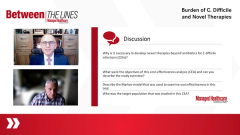
Target Population In Analysis
Brief rundown of patient demographics involved in REBYOTA trials and this cost-effectiveness analysis.
Dr. Paul Feuerstadt: As a clinician, it’s important. We have to think about these things and we have to think about really the cost-efficiency of using products like this. I think this study does a nice job at providing an ultra structure for this. Now, within the study, the target population was consistent with the clinical trials for RBL [live JSLM; Rebyota]. Specifically they included patients that had one or more recurrence of C. diff or two severe episodes requiring hospitalization within the prior year. They kept the demographics fairly consistent. The average age was 60.1 [years] and 69.1% of them were women so again, fitting with the demographics that were seen in the prospective randomized controlled trials in the open label study for this product. Very importantly, the outcomes that were used as part of the modeling for this came directly from the studies; the PUNCH-CD3 [NCT03244644 ] pivotal phase 3 trial for RBL, the open label study and of course historical literature. Michael, can you walk us through some of the main cost inputs for this cost-efficiency analysis?
Dr. Michael Kobernick: [Yes], so what I’ve got for the cost inputs, it’s really interesting. … [It’s] what you would think, and this is the part that isn’t so complicated. Cost inputs are the cost of the medications to treat in both groups, antibiotic costs are negligible, the cost input of RBL, I think, was rated at [approximately] $9,000. The cost … related to the treatments in each group so outpatient visits, imaging, hospitalization, [emergency department] visits. Those were all added together to come up with a total cost of care for each group.
Dr. Paul Feuerstadt: Again, as a clinician it’s sometimes hard to wrap our head around the sort of soup to nuts or… all the ingredients that go into considering something like this because we sort of touch the patient at one point. We might see them as an [emergency department] physician and say well, “I’m going to triage and send them upstairs or as a gastroenterologist then I’m going to consult on them but not be the hospitalist caring for them.” So really this is sort of the 30,000-foot overview of the entire situation, the entirety of the costs.
Transcript is AI-generated and edited for clarity and readability.
Newsletter
Get the latest industry news, event updates, and more from Managed healthcare Executive.



















































